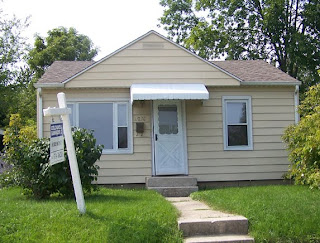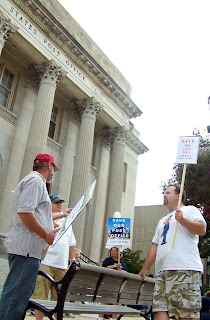 The blue markers indicate rundown homes the city of Racine is buying with $1.9 million in stimulus money it received from the federal government for "Neighborhood Stabilization." All of the homes are in disrepair and are now unlivable. Seven will be remodeled and sold for less than $75,000. Two will be demolished. Click on the map above for an interactive map showing the addresses, the city's purchase price and which home will be demolished.
The blue markers indicate rundown homes the city of Racine is buying with $1.9 million in stimulus money it received from the federal government for "Neighborhood Stabilization." All of the homes are in disrepair and are now unlivable. Seven will be remodeled and sold for less than $75,000. Two will be demolished. Click on the map above for an interactive map showing the addresses, the city's purchase price and which home will be demolished. The city is set to buy nine homes east of Ohio Street to rehab or demolish.
The Loan Board of Review agreed Tuesday morning to use a portion of the city's $1.9 million in "Neighborhood Stabilization" stimulus money to buy the homes and, hopefully, turn the distressed properties into owner-occupied homes. The city already has accepted offers on all nine properties.
The homes purchases include:
 1706 Maple St. -
1706 Maple St. - The city bought this home near West Sixth Street for $24,900. It's assessed at $64,000. The city hopes to rehab the home to protect its investment in the West Sixth Street neighborhood in recent years.
 1537 Thurston Ave. -
1537 Thurston Ave. - This West Racine home was the city's most expensive purchase at $58,000. But it's also the nicest home on the list, according to Jean Wolfgang, of the city development department. Wolfgang coordinated the purchases of all nine homes. The city is buying the three-bedroom house from US Department of Housing and Urban Development.
 2026 Orchard St. -
2026 Orchard St. - The city bought this home just east of Ohio Street for $45,000. Located in a good neighborhood, this home should sell, Wolfgang said.
 826 Forest St. -
826 Forest St. - Another HUD foreclosure, Wolfgang described this home as the "tiltin' Hilton" because the inside is such a mess. The city is buying the home for $15,100 - the value of the land - and tearing the house down. (The home was assessed at $80,000, based largely on its exterior appearance, officials said. The interior is unlivable.)
 1317 Albert St. -
1317 Albert St. - The city bought this home for a $14,900 and plans to spend $30,000 to rehab it. They're buying the home from Wells Fargo bank. (The city gave priority to working with local lenders, including Tri-City Bank and Bank of Elmwood, but didn't have luck with either of them. Deals with Tri-City fell through, and Bank of Elmwood didn't respond to offers.)
 1124 Irving Place -
1124 Irving Place - This home just east of Washington Avenue off of 11th Street is a big house with a new kitchen. The city bought it for $30,000.
 630 Hagerer St. -
630 Hagerer St. - Located north of High St. just off of N. Main Street, this is a two-family home the city bought for $35,000. HUD had listed the duplex at $64,000. Housing Technician Bill Bielefeldt said this was a home worth investing in. "The neighborhood is on the edge," he said. "We don't want to see this sitting there too long."
 1100 MLK Drive -
1100 MLK Drive - Located near the King Community Center and Julian Thomas Elementary School, Assistant Development Director Joe Heck said this home was "awful 30 years ago. I have nothing good to say about it." The city bought the home for $10,600 and will tear it down. The lot, located near the former Homeward Bound site, will hopefully be used for new construction.
The nine selected properties are part of 14 homes - 10 for rehab and four for demolition - the city plans to buy with the stimulus money, Heck said. Once these purchases are completed, Wolfgang will start work on the next properties.
All of the rehabbed homes will be sold as owner-occupied properties with restrictions on the loan or deed to ensure people don't turn the buildings over to landlords for rentals. The stimulus bill requires the home to sell for the amount of money the city puts into the homes. (Meaning the city can't make money on the sale.) The city capped its commitment to any one property at $75,000.
All of the buildings are abandoned, with most in foreclosure. Federal law prohibits the city from buying occupied homes. It also limits sales to 95 percent of the homes appraised value. (Meaning the city can't buy a home for more than its worth.)
The purchase process began in January when the city applied for the Neighborhood Stabilization stimulus money. The City Council approved the grant in April, and turned over approval of all purchases to the Loan Board of Review, which is made up of city legal, development, building and finance staff. No City Council members sit on the board, which has existed for 30 years.
Alderman Greg Helding attended the Tuesday meeting because he was surprised the council didn't get final approval over the purchases properties. But he also acknowledged the council handed over that approval to the Loan Board of Review in April. "Shame on me for not reading the entire grant application," he said. (Helding added it made sense for the Loan Board of Review to handle the program because the right experts sat on the board.)
Helding also asked that, in the future, the council be given a heads up on the criteria used to select the properties. (Wolfgang began the meeting by laying out a point system she used to score properties reviewed for purchase.) City officials said they will put the scoring system, along with all properties review for purchase, on the
Department of Development's website.
 Ken's clothes have been donated to HALO, but Jan brought two dozen of his motorcycle t-shirts (all neatly washed and folded) for his friends to hand out at future gatherings.
Ken's clothes have been donated to HALO, but Jan brought two dozen of his motorcycle t-shirts (all neatly washed and folded) for his friends to hand out at future gatherings.












































